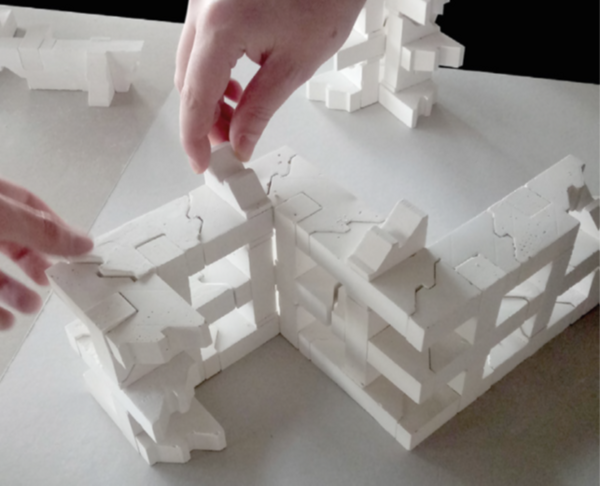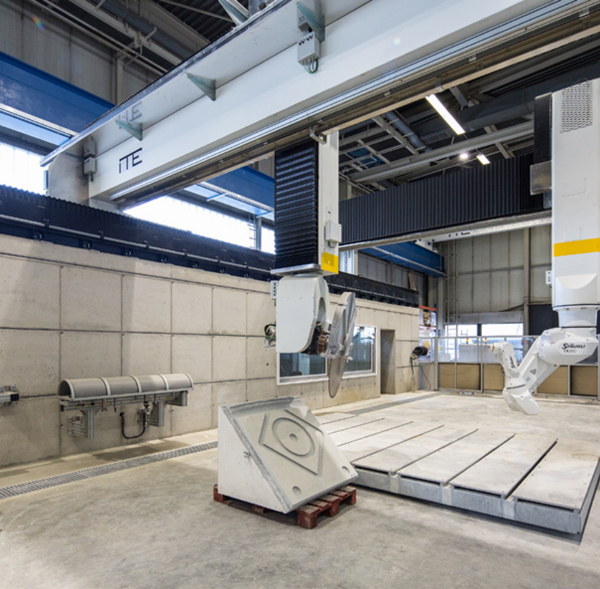Fertigteil 2.0
Resource-efficient circular economy - construction and mineral material cycles (ReMin)
In the Prefabricated Part 2.0 project, concrete components from buildings destined for demolition are recovered as reusable "finished components" for new buildings. Based on a new type of real-digital process chain, buildings are digitized and mapped as a digital twin in a BIM model. The concrete components are then joined together to form flexible new prefabricated structures.
The project is being funded as part of the "Resource-efficient circular economy - construction and mineral material cycles (ReMin)" funding measure. "ReMin" is part of the BMBF research concept "Resource-efficient circular economy" and is aimed at resource-efficient construction and the expanded use of mineral secondary raw materials from construction waste, slag, ash and mining residues.
Circular economy in the construction industry
Global climate change, increasing scarcity of resources and a constantly rising demand for buildings require the implementation of genuine material and economic cycles. The construction industry makes a significant contribution to global resource consumption, as many material flows are still organized in a linear and non-recyclable manner. Particularly in the case of mineral raw materials and building components, the majority of materials are no longer reused after their first use. The need for a circular economy has recently become apparent for a large number of building materials - especially for a supposedly inexhaustible resource for building with concrete. Sand, for example, is becoming a scarce resource. While there are at least guidelines for the use of recycled concrete at material level, there is no approach to reuse at component level. The primary energy and engineering planning work tied up in the production of buildings is largely lost as a result. Existing buildings already consist of "finished components" that can be reused. Today, we have the technological basis to use large parts of construction waste as valuable raw materials for further use. The Finished Part 2.0 project is developing innovative strategies and digital process chains to contribute to this necessary paradigm shift.
From digital-real to real-digital
Fertigteil 2.0 brings together experts in architecture, engineering, surveying and building digitization. The interdisciplinary team is working on reversing the conventional digital-real process chains: While building planning currently begins with a digital planning process and the planned building is then materialized, Fertigteil 2.0 starts with an existing building destined for demolition. Concrete components, obtained through the controlled dismantling of existing buildings, are first digitized, catalogued, digitally processed and then transformed into new, refurbished precast concrete parts using robotics in a real-digital process chain. Innovative software solutions are then used to assemble these discrete elements into dry-joined structures, turning them into both the buildings of today and the component warehouse for the buildings of tomorrow.

Linking existing key technologies
The aim of the project is a directly applicable real digital process chain that intelligently combines existing technologies such as digital recording, algorithmic planning, production, data management, life cycle analysis and logistics. The closed economic cycle of precast elements 2.0 is thus modeled and processed on a digital platform. A demonstrator made from reused precast elements 2.0 illustrates the process chain. Existing building structures are digitized by FARO and reusable concrete parts are identified. These are clearly identified by RFID markings and transferred into a digital twin using BIM models from THING TECHNOLOGIES. Once the building has been dismantled, the components are uniformized for further use through subtractive post-processing by the Institute of Structural Engineering (ITE). The Digital Design Unit (DDU) develops software solutions based on discrete, graph-based methods and combinatorial optimization processes in order to implement architectural designs with a maximum of prefabricated parts 2.0. The Department of Design and Sustainable Building (ENB) accompanies this entire process with a comprehensive life cycle analysis in order to quantify the ecological and economic impact of this process chain.

Funding measure
Resource-efficient circular economy - construction and mineral material cycles (ReMin)
Project title
FERTIGTEIL 2.0 - Real-digital process chains for the extraction of built-in concrete components for further use as finished components
Duration
01.03.2021-28.02.2023
Funding reference
033R255
Funding volume of the consortium
597,649 euros
Contact
Prof. Dr.-Ing. Oliver Tessmann
Technical University of Darmstadt | Department of Architecture
DDU - Digital Design Unit - Digital Design
El-Lissitzky-Str.1 | 64287 Darmstadt
Phone: 06151 16-22483
Email: tessmann@dg.tu-darmstadt.de
Project participants
Institute for Structural Design (ITE), TU Braunschweig; THING TECHNOLOGIES GmbH; FARO Europe GmbH
Data sheet
Download data sheet